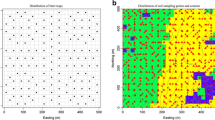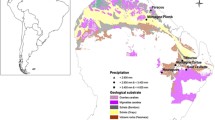Abstract
Data on soil nutrient availability for humid tropical forests are often reported, but are rarely integrated in an ecologically meaningful way with other measures of nutrient cycling. In this paper, estimates of soil nutrient availability and the inverse of litterfall nutrient concentrations (as an index of plant nutrient use) were compared, using data from 36 sites throughout the humid tropics, to determine if relationships exist between commonly used indices of nutrient cycling for plants and soils. Measures of both extractable and total soil P were significantly and positively correlated with the ratio of litterfall mass/P, particularly for montane tropical forests. Extractable soil P was also significantly correlated with litterfall mass for lowland humid tropical forests, explaining 58% of the variability in litterfall mass. A weak, albeit significant correlation was found between exchangeable soil Ca and litterfall mass/Ca, even though soil extraction techniques vary greatly. No significant relationship was found for total soil N, the most commonly measured soil N pool, and the inverse of litterfall N concentrations. The results suggest that our indices of soil P are related to litterfall processes, but that other measures, particularly total soil N, may not be as relevant to nutrient cycling by the vegetation.
Similar content being viewed by others
References
Anderson JM (ed) (1987) Tropical soil biology and fertility IUBS/UNESCO UK
Barlett R, James B (1980) Studying dried, stored soil samples-some pitfalls. Soil Sci Soc Am J 44: 721–724
Berendse F, Aerts R (1987) Nitrogen-use efficiency: a biologically meaningful definition? Func Ecol 1: 293–296
Bremner JM, Mulvaney CS (1982) Nitrogen-total. In: Page AL (ed) Methods of soil analysis. II. Chemical and microbiological properties. American Society of Agronomy, Madison, Wis, pp 595–624
Buschbacher RJ (1984) Changes in productivity and nutrient cycling following conversion of Amazon rainforest to pasture. PhD Dissertation, University of Georgia
Caldwell MM, Dudley LM, Lilieholm B (1992) Soil solution phosphate, root uptake kinetics, and nutrient acquisition: implications for a patchy soil environment. Oecologia 89: 305–309
Chapin FS (1980) The mineral nutrition of wild plants. Annu Rev Ecol Syst 11: 233–260
Cuevas E, Medina E (1988) Nutrient dynamics within Amazonian forests: fine root growth, nutrient availability, and leaf litter decomposition. Oecologia 76: 222–235
Cuevas E, Brown S, Lugo AE (1991) Above-and below-ground organic matter storage and production in a tropical pine plantation and a paired broadleaf secondary forest. Plant Soil 135: 257–268
Denslow JS, Vitousek PM, Schultz JC (1987) Bioassays of nutrient limitation in a tropical rainforest soil. Oecologia 74: 370–376
Edmisten J (1970) Soil studies in the El Verde Rain Forest. In: Odum HT, Pigeon RF (eds) A Tropical Rain Forest. NTIS, Virginia, USA. pp 15–20
Edwards PJ (1982) Studies of mineral cycling in a montane rain forest in New Guinea. V. Rates of cycling in throughfall and litter fall. J Ecol 70: 807–827
Edwards PJ, Grubb PJ (1982) Studies of mineral cycling in a montane rain forest in New Guinea. IV. Soil characteristics and the division of mineral elements between the vegetation and soil. J Ecol 70: 649–666
Gower ST, Vitousek PM (1989) Effects of nutrient amendments on fine root biomass in a primary successional forest in Hawaii. Oecologia 81: 566–568
Grubb PJ (1977) Controls on forest growth and distribution on wet tropical mountains with specific reference to mineral nutrition. Annu Rev Ecol Syst 8: 83–107
Haynes RJ, Swift RS (1989) The effects of pH and air-drying on adsorption of phosphate by aluminum-organic matter associations. J Soil Sci 40: 773–781
Heaney A, Proctor J (1989) Chemical elements in litter in forests on Volcan Barva, Costa Rica. In: Proctor J (ed) Mineral nutrients in tropical forest and savanna ecosystems. Blackwell, Oxford. pp 255–271
Herrera RA (1979) Nutrient distribution and cycling in an Amazon Caatinga forest on spodosols in southern Venezuela. PhD Dissertation University of Reading
Hunter AH (1982) International soil fertility and improvement: laboratory procedures. Department of Soil Science, North Carolina State University, Raleigh, NC
Janos DP (1980) Vesicular-arbiscular mycorrhizae affect lowland tropical rainforest plant growth. Ecology 61: 151–162
Jenny H (1980) The soil resource. Springer, New York Berlin Heidelberg 377 p
Jordan CF (1985) Nutrient cycling in tropical forest ecosystems. Wiley, New York
Lodge DJ, Scatena FN, Asbury CE, Sanchez MJ (1991) Fine litterfall and related nutrient inputs resulting from Hurricane Hugo in subtropical wet and lower montane rain forests of Puerto Rico. Biotropica 23: 336–342
Lugo AE (1992) Comparison of tropical tree plantations with secondary forests of similarage. Ecol Monogr 62: 1–41
Medina E, Cuevas E (1989) Patterns of nutrient accumulation and release in Amazonian forests of the upper Rio Negro basin. In: Proctor J (ed) Mineral Nutrients in tropical forest and savanna ecosystems. Blackwell, Oxford, pp 217–140
Meetnmeyer V, Box EO, Thompson R (1982) World patterns and amounts of terrestrial plant litter production. BioScience 32: 125–128
Olsen SR, Sommers LE (1982) Phosphorus. In: Page AL (ed) Methods of Soil analysis. II. Chemical and microbiological properties. American Society of Agronomy, Madison, Wis, pp 403–448
Proctor J, Anderson JM, Chai P, Vallack HW (1983a) Ecological studies in four contrasting lowland rain forests in Gulung Mulu National Park, Sarawak. I. Forest environment and floristics. J Ecol 71: 237–260
Proctor J, Anderson JM, Fogden SCL, Vallack HW (1983b) Ecological studies in four contrasting lowland rain forests in Gulung Mulu National Park, Sarawak. II. Litterfall, litter standing crop and preliminary observations on herbivory. J Ecol 71: 261–283
Proctor J, Anderson JM, Vallack HW (1983c) Comparative studies on forests, soil, and litterfall at four altitudes on Gunung Mulu, Sarawak. Malays For 46: 60–76
Proctor J, Lee YF, Langley AM, Munro WRC, Nelson T (1988) Ecological studies on Gunung Silam, a small ultrabasic mountain in Sabah, Malaysia. I. Environment, forest structure, and floristics. J Ecol 76: 320–340
Proctor J, Phillips C, Duff GF, Heaney A, Robertson FM (1989) Ecological studies on Gunung Silam, a small ultrabasic mountain in Sabah, Malaysia. II. Some forest processes. J Ecol 77: 317–331
Rhoades JD (1982) Cation exchange capacity In: Page AL (ed) Methods of Soil analysis. II. Chemical and microbiological properties. American Society of Agronomy, Madison, Wis, pp 149–158
Runge M (1983) Physiology and ecology of nitrogen nutrition. In: Lange OL, Nobel PS, Osmond CB, Ziegler H (eds) Physiological plant ecology. III. Responses to the chemical and biological environment. Springer, New York Berlin Heidelberg, pp 163–200
Sanchez PA (1976) Properties and management of soils in the tropics. Wiley, New York 468 p
Sanford RL (1989) Fine root biomass under a tropical light gap opening in Costa Rica. J Trop Ecol 5: 153–159
Silver WL, Scatena FN, Johnson AJ, Siccama TG, Sanchez MJ (1994) Nutrient availability in a montane wet tropical forest: spatial patterns and methods logical considerations. Plant and soil (in press)
Silver WL, Vogt KA (1993) Fine root dynamics following single and multiple disturbances in a subtropical wet forest ecosystem. J Ecol 81:729–738
Stark N, Spratt M (1977) Root biomass and nutrient storage in rain forest oxisols near San Carlos de Rio Negro. Trop Ecol 18: 1–9
Tanner EVJ (1977) Four montane rain forests of Jamaica: a quantitative characterization of the floristics, the soils and the foliar mineral levels, and a discussion of the interrelations. J Ecol 65: 883–918
Tanner EVJ, Kapos V, Freskos S, Healey JR, Theobald AM (1990) Nitrogen and phosphorus fertilization of Jamaican montane forest trees. J Ecol 6: 231–238
Tanner EVJ, Kapos V, Franco W (1992) Nitrogen and phosphorus fertilization effects on Venezuelan montane forest trunk growth and litterfall. Ecology 73: 78–86
Tie YL, Baillie IC, Phang MS, Lim CP (1979) Soils of the Gunung Mulu National Park, Department of Agriculture, Sarawak
Uhl C, Jordan CF (1984) Succession and nutrient dynamics following forest cutting and burning in Amazonia. Ecology 65: 1476–1490
Vitousek PM (1982) Nutrient cycling and nutrient-use efficiency. Am Nat 119: 553–572
Vitousek PM (1984) Litterfall nutrient cycling and nutrient limitation in tropical forests. Ecology 65: 285–298
Vitousek PM, Sanford RL Jr (1986) Nutrient cycling in moist tropical forest. Annu Rev Ecol Syst 17: 137–167
Vitousek PM, Gosz JR, Grier CC, Melillo JM, Reiners WA (1982) A comparative analysis of potential nitrification and nitrate mobility in forest ecosystems. Ecol Monogr 52: 155–177
Vitousek PM, Walker LR, Whittaker LD, Mueller-Dombois D, Matson PA (1987) Biological invasion by Myrica faya alters ecosystem development in Hawaii. Science 238: 802–804
Vitousek PM, Walker LR, Whiteaker LD, Matson PA (1994) Nutrient limitation to plant growth during primary succession in Hawaii Volcanoes National Park. Biogeochemistry (in Press)
Vogt KA, Grier CC, Vogt DJ (1986) Production turnover, and nutrient dynamics of above-and below-ground detritus of world forests. Adv Ecol Res 15: 303–377
Vogt KA, Publicover DA, Bloomfield J, Perez JM, Vogt DJ, Silver WL (1993) Belowground responses as indicators of environmental change. Environ Exper Bot 33: 189–205
Weaver PL, Medina E, Pool D, Dugger K Gonzales-Liboy J, Cuevas E (1986) Ecological observations in the dwarf cloud forest of the Lupuillo Mountains in Puerto Rico. Biotropica 18: 79–85
Went FW, Stark N (1968) Mycorrhiza. BioScience 18: 1035–1039
Wilkinson L (1990) Systat. Systat Inc Evanston, IL
Author information
Authors and Affiliations
Rights and permissions
About this article
Cite this article
Silver, W.L. Is nutrient availability related to plant nutrient use in humid tropical forests?. Oecologia 98, 336–343 (1994). https://doi.org/10.1007/BF00324222
Received:
Accepted:
Issue Date:
DOI: https://doi.org/10.1007/BF00324222




